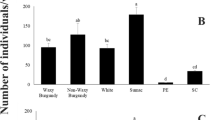Abstract
Trials were planted at Rio Bravo, Tamaulipas, Mexico, during 2002 and 2003 with the objective of determining the relationship between sorghum ergot severity and weather factors, and to develop a risk assessment model. Six sorghum hybrids and three male-sterile genotypes were planted every month from January to October. At anthesis initiation, inoculation was conducted using a local isolate of Claviceps africana. Among hybrids, there was a negative relationship between ergot severity and maximum and minimum temperatures, with the highest significant correlation of —0.71 from 7 to 9 days before anthesis. During this period, minimum temperatures above 10°C increased the risk of ergot development, whereas minimum temperatures above 22.5°C prevented ergot development. In male-sterile plants, ergot was negatively related to maximum temperature after anthesis, with ergot being observed at maximum temperatures up to 38°C. Minimum relative humidity showed a positive and significant correlation with ergot severity. Values of minimum relative humidity above 30% during anthesis promoted infection. Surface response regression models were developed for the effects of minimum relative humidity and minimum and maximum temperature during the infection process on ergot severity.
Similar content being viewed by others
References
Aguirre RJI, Williams AH, Montes GN, Cortinas EH (1997) First report of sorghum ergot caused by Sphacelia sorghi in Mexico. Plant Disease 81, 831. doi: 10.1094/PDIS.1997.81.7.831C
Bandyopadhyay R, Frederickson DE, McLaren NW, Odvody GN (1996) Ergot — a global threat to sorghum. International Sorghum and Millets Newsletter 37, 1–32.
Bandyopadhyay R, Frederickson DE, McLaren NW, Odvody GN, Ryley MJ (1998) Ergot: a new disease threat to sorghum in the Americas and Australia. Plant Disease 82, 356–367. doi: 10.1094/PDIS.1998.82.4.356
Bhuiyan SA, Galea VJ, Ryley MJ, Tay D, Lisle AT (2002) Factors influencing the germination of macroconidia and secondary conidia of Claviceps africana. Australian Journal of Agricultural Research 53, 1087–1094. doi: 10.1071/AR02029
Brooking IR (1976) Male sterility in Sorghum bicolor (L.) Moench induced by low night temperature. Timing of the stage of sensitivity. Australian Journal of Plant Physiology 3, 589–596.
De Wolf ED, Madden LV, Lipps PE (2003) Risk assessment models for wheat fusarium head blight epidemics based on within weather data. Phytopathology 93, 428–435. doi: 10.1094/PHYTO.2003.93.4.428
Downes RW, Marshall DR (1971) Low temperature induced male sterility in Sorghum bicolor. Australian Journal of Agriculture and Animal Husbandry 11, 352–356. doi: 10.1071/EA9710352
Futrell MC, Webster OJ (1965) Ergot infection and sterility in grain sorghum. Plant Disease Reporter 49, 680–683.
Futrell MC, Webster OJ (1966) Host range and epidemiology of the sorghum ergot organism. Plant Disease Reporter 50, 828–831.
Gupta GK, Subbarao GV, Saxena MBL (1983) Relationship between meteorological factors and the occurrence of ergot disease (Claviceps microcephala) of pearl millet. Tropical Pest Management 29, 321–324. doi: 10.1080/09670878309370826
Isakeit T, Odvody GN, Shelby RA (1998) First report of sorghum ergot caused by Claviceps africana in the United States. Plant Disease 82, 592. doi: 10.1094/PDIS.1998.82.5.592A
Isakeit T, Barroso M, Garza B (1999) Ergot reaction of grain sorghum hybrids, 1998. Biological and Cultural Tests for Control of Plant Diseases 14, 19.
McLaren NW, Flett BC (1998) Use of weather variables to quantify sorghum ergot potential in South Africa. Plant Disease 82, 26–29. doi: 10.1094/PDIS.1998.82.1.26
McLaren NW, Wehner FC (1990) Relationship between climatic variables during early flowering of sorghum and the incidence of sugary disease caused by Sphacelia sorghi. Journal of Phytopathology 130, 82–88. doi: 10.1111/j.1439-0434.1990.tb01155.x
McLaren NW, Wehner FC (1992) Pre-flowering low temperature predisposition of sorghum to sugary disease (Claviceps africana). Journal of Phytopathology 135, 328–334. doi: 10.1111/j.1439-0434.1992.tb04318.x
Montes GN, Odvody GN, Williams AH (2003a) Relationship between climatic variables and Claviceps africana incidence on sorghum hybrids in northern Mexico. In ‘Sorghum and millet diseases’. (Ed. John F Leslie) pp. 111–112. (Iowa State Press: Ames, IA)
Montes GN, Odvody GN, Marin Silva M (2003b) Effect of cold degree units on incidence of Claviceps africana in sorghum hybrids. In ‘Sorghum and millet diseases’. (Ed. John F Leslie) pp. 103–104. (Iowa State Press: Ames, IA)
Montes-Belmont R, Mendez-Ramirez I, Flores-Moctezuma E (2002) Relationship between sorghum ergot, sowing dates, and climatic variables in Morelos, Mexico. Crop Protection (Guildford, Surrey) 21, 899–905. doi: 10.1016/S0261-2194(02)00056-X
Quinby JR (1958) Grain sorghum production in Texas. Texas Agric. Exp. Station Bulletin 912. Texas A&M University, College Station.
Ryley M (2005) Pollen release in the Australian commercial grain sorghum hybrid cultivar, MR Buster. International Sorghum and Millets Newsletter 46, 25–28.
Vanderplank JE (1963) ‘Plant diseases: epidemics and control.’ (Academic Press: New York) 349 pp.
Wang E, Meinke H, Ryley M, Herde D, Henzell B (2000) On the relation between weather variables and sorghum ergot infection. Australian Journal of Agricultural Research 51, 313–324. doi: 10.1071/AR99072
Wang E, Meinke H, Ryley M (2003) Effect of climatic variability on frequency of sorghum ergot outbreaks in Australia. In ‘Solutions for a better environment. Proceedings of the 11th Australian agronomy conference, 2–6 February, 2003, Geelong, Victoria’. (Eds M Unkovich, G O’Leary) (Australian Society of Agronomy: Horsham, Vic. Australia)
Workneh F, Rush CM (2002) Evaluation of relationships between weather patterns and prevalence of sorghum ergot in the Texas Panhandle. Phytopathology 92, 659–666. doi: 10.1094/PHYTO.2002.92.6.659
Workneh F, Rush CM (2006) Weather factors associated with development of sorghum ergot in the Texas Panhandle. Plant Disease 90, 717–722.
Author information
Authors and Affiliations
Corresponding author
Rights and permissions
About this article
Cite this article
Montes-García, N., Prom, L.K., Williams-Alanis, H. et al. Effect of temperature and relative humidity on sorghum ergot development in northern Mexico. Australasian Plant Pathology 38, 632–637 (2009). https://doi.org/10.1071/AP09049
Received:
Accepted:
Issue Date:
DOI: https://doi.org/10.1071/AP09049




